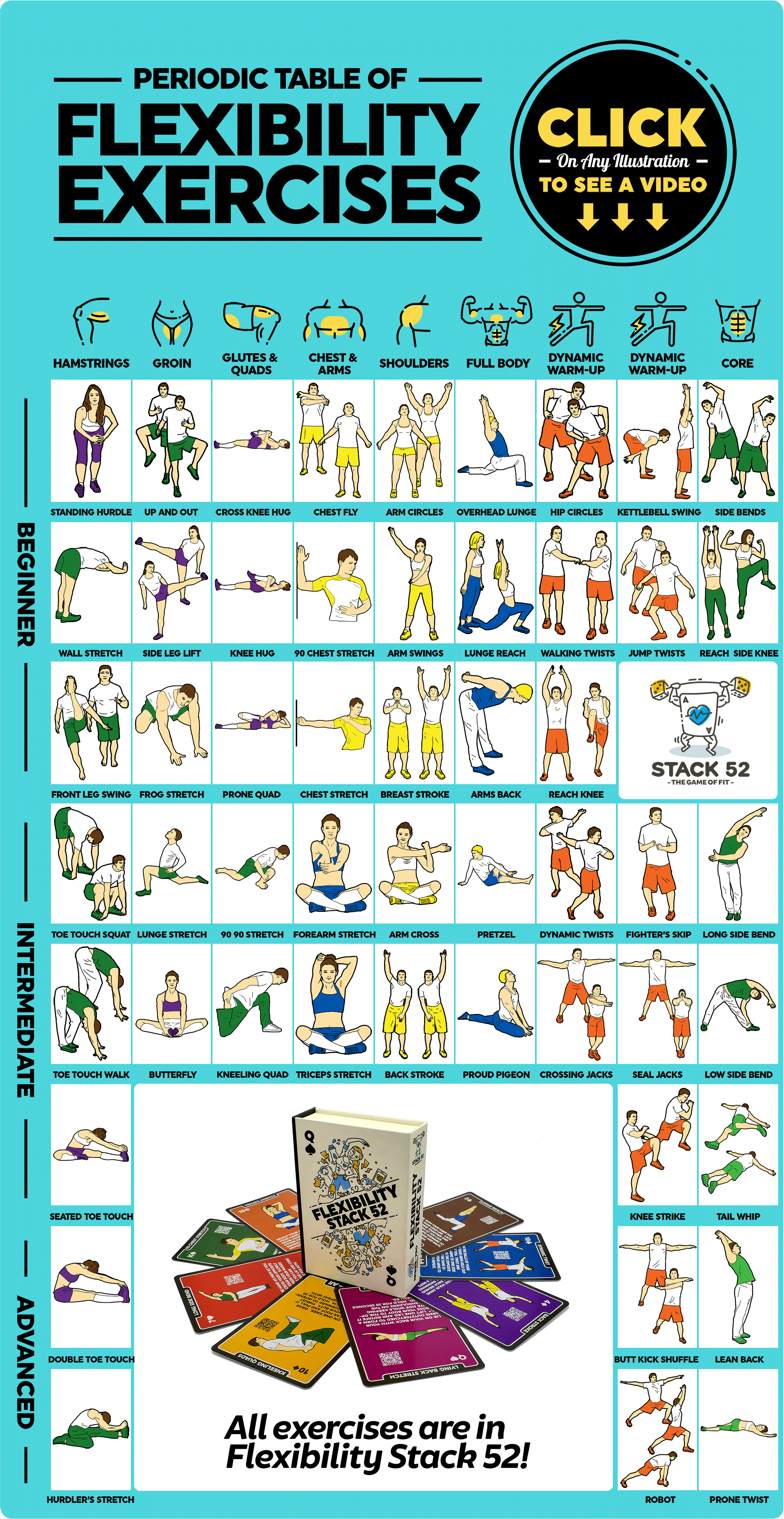Periodic Table of Flexibility Exercises
Stretching increases your joint range of motion, warms up your muscles, and aids in muscle recovery. There are two different types of flexibility, static flexibility and dynamic flexibility. Static Flexibility is the range of motion of a joint with very slow, controlled movement. Dynamic Flexibility is the range of motion of a joint with fast, explosive movement. Your static flexibility is probably higher than your dynamic flexibility (perhaps you can do the splits, but can you jump and drop into the splits?), but dynamic flexibility is more important for most athletic activity.
So what limits flexibility and how do we become more flexible? The mechanical nature of our joints and ligaments determine our ultimate range of motion, but our working flexibility is limited by our brain! Our brains instinctually cause our muscles to tighten to limit our range of motion to prevent injury. Stretching exercises help build strength at extreme joint angles and “teach” our brains that this range of motion is safe; it does not need to tighten our muscles to prevent it.
There are several different methods of stretching we should know about:
- Dynamic Stretching: Move a joint back and forth through its full range of motion. We recommend dynamic stretching as a warm up before any activity. Dynamic stretching is also crucial for increasing your dynamic flexibility.
- Static Stretching: Relax and try to move a joint past its current range of motion. We like using these stretches to warm up tight muscles or prevent an injured muscle from losing range of motion.
- PNF (proprioceptive neuromuscular facilitation) Stretching: Similar to static stretching, but you actively flex your muscles against the stretch for several seconds, relax, and then find you are able to move the joint a little further. PNF stretching is scientifically proven to be one of the most effective ways for increasing static flexibility.
- Ballistic Stretching: Move a joint past its working range of motion quickly and explosively. Done incorrectly, these will cause injury and reduce your flexibility (your brain will cause the muscles to tighten to fight the stretch and prevent further injury). Done correctly, these are really just a more intense dynamic stretch. These should only be done by athletes who are very tuned to their bodies and know precisely how hard to push the motion.
The Periodic Table of Stretching Exercises lists over 50 different stretches. The table is arranged by muscle group horizontally. There are stretching exercises for your arms, chest, glutes, quads, hamstrings, groin, shoulders, back and core. There are also compound full body stretches and many dynamic warm up stretches.
The stretching exercises are arranged vertically by difficulty. At the top are the simplest stretches that are the easiest to learn and perform. As you move further down the table, the stretches become increasingly difficult, requiring more flexibility and/or coordination to perform.
Click on any illustration for a quick video demonstration of that stretch. We hope you enjoy this infograph and spend some time learning these flexibility exercises. We spent many hours putting this together, so please share it! You might also enjoy the Periodic Table of Bodyweight Exercises, the Periodic Table of Suspension (TRX) Exercises, the Periodic Table of Dumbbell Exercises, the Periodic Table of Kettlebell Exercises, the Periodic Table of Exercise Ball Exercises, the Periodic Table of Resistance Band Exercises, the Periodic Table of Barbell Exercises, or the Periodic Table of Yoga Poses.






